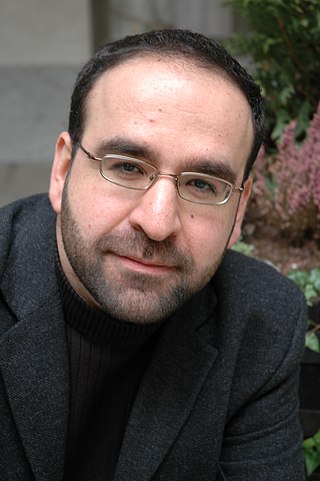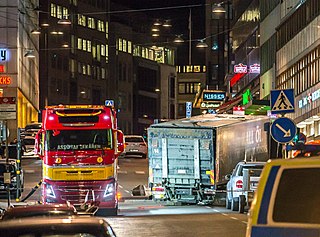
The Swedish International Development Cooperation Agency is a government agency of the Swedish Ministry for Foreign Affairs. Sida is responsible for organization of the bulk of Sweden's official development assistance to developing countries. According to the OECD, 2022 official development assistance from Sweden increased to US$5.5 billion, representing 0.9% of their Gross National Income (GNI).

Crime in Sweden is defined by the Swedish Penal Code and in other Swedish laws and statutory instruments.

Stockholm Västerås Airport, also known as Hässlö Flygplats, is a minor international airport located near the city of Västerås, Sweden. The airport is located 110 km (70 mi) west of Stockholm, and is outside of Stockholm County, but is included in STO, the IATA airport code for Stockholm airports. The airport handled a total of 78,652 passengers in 2024, making it Sweden's 18th-busiest airport.

Mehmet Güner Kaplan is a Swedish politician of Turkish origin who served as Minister for Housing and Urban Development from 2014 to 2016. He is a member of the Swedish Green Party.

Swedish contact with the Muslim world dates back to the 7th–10th centuries, when the Vikings traded with Muslims during the Islamic Golden Age. Since the late 1960s and more recently, Muslim immigration from the Middle East, Balkans and Horn of Africa has impacted the demographics of religion in Sweden, and has been the main driver of the spread of Islam in the country. Islam in Sweden increased at most as a result of high refugee influxes, notably during the Yugoslav Wars and the Somali Civil War in the 1990s, Iraq War in the 2000s and Syrian civil war in the 2010s.

Musikhjälpen is a Swedish televised benefit performance radio show marathon. The annually recurring show is a charity fundraiser for a chosen cause, the cause is changed each year. Three radio hosts or television personalities are locked inside a glass building for 144 hours. Each presenter acts as a host for eight hours respectively, totaling three shifts per day. It is broadcast in December, during one week, with dates varying each year.

The Swedish Civil Contingencies Agency is a Swedish administrative authority, organised under the Ministry of Defence. The agency is responsible for issues concerning civil protection, public safety, emergency management and civil defence. Responsibility refers to measures taken before, during and after an emergency or crisis. MSB work in close cooperation with the municipalities, the county councils, other authorities, organisations and the private sector to achieve increased safety and security at all levels of society. This is done through education, support, training exercises, regulation and supervision.

Kjell Stefan Löfven is a Swedish politician who has served as the President of European Socialists since October 2022. He previously served as Prime Minister of Sweden from October 2014 to November 2021 and leader of the Social Democratic Party from 2012 to 2021.
Events from the year 2001 in Sweden
On 15 May 2016, unrest occurred simultaneously in the Swedish towns of Norrköping and Borlänge, primarily in Million Programme Muslim-dominated public housing-areas, with stone-throwing against police and firefighters, car fires and arson attacks. The unrest took place across Sweden since late March. Public transportation was temporarily suspended in several areas due to stone-throwing against trams and buses. These incidents were mainly perpetrated by Muslim youths. These incidents were considered particularly notable as they represented the spread of unrest to outside the three major urban areas of Sweden. Across Sweden, more than 2,000 cars were set on fire between January and July 2016.

On 7 April 2017, a vehicle-ramming Islamist terrorist attack took place in central Stockholm, the capital of Sweden. A hijacked truck was deliberately driven into crowds along Drottninggatan before being crashed into an Åhléns department store. Five people were killed and 14 others were seriously injured.
Vulnerable area is a term applied by the Swedish Police Authority to areas with high crime rates and social exclusion. They are not referred to in Sweden as no-go zones, neither by police nor the population in general. In the December 2015 report, there were 53 vulnerable areas, which increased to 61 in June 2017. The increase is reported to be due to better reporting, not a changing situation. The overall trend is that these areas are improving.
Gun violence in Sweden increased steeply among males aged 15 to 29 in the two decades prior to 2015, in addition to a rising trend in gun violence there was also a high rate of gun violence in Sweden compared to other countries in Western Europe.
Bombings in Sweden are attacks and sabotage using explosive devices by criminals in Sweden. The weapons used are weapons such as hand grenades and explosives intended for either civilian or military use. Legal authorities use the term allmänfarlig ödeläggelse genom sprängning and media in Sweden use the shorter term sprängdåd. This crime was not categorized separately prior to 2017. In 2018 there were 162 explosions, and in the first nine months of 2019, 97 explosions were registered, usually carried out by criminal gangs. According to Swedish police commissioner Anders Thornberg in 2019, there is no international equivalent to Sweden's wave of bombings.
Events in the year 2020 in Sweden.

The COVID-19 pandemic in Sweden is a part of the pandemic of coronavirus disease 2019 caused by severe acute respiratory syndrome coronavirus 2. As of 22 March 2023, there have been 2,701,192 confirmed cumulative cases and 23,851 deaths with confirmed COVID-19 in Sweden. Sweden ranks 57th in per capita deaths worldwide, and out of 47 European countries, Sweden places 30th. A 2022 estimate of excess mortality during the pandemic using IHME COVID model estimated 18,300 excess deaths during 2020–2021 The Economist model value estimated 13,670 excess deaths between 16th 2020-Mar 6th 2022.

Sweden's unique response to the COVID-19 pandemic has been the subject of significant controversy in both domestic and international circles. Unlike most countries, which strongly recommended or introduced widespread sector closures, quarantining, and lockdown measures to curb the spread of the coronavirus disease 2019, the government of Sweden took a more lenient approach to the pandemic, prioritizing the economy and only pursuing social distancing measures such as bans on large gatherings and limited travel restrictions.
On 29 August 2020, riots broke out in the Swedish cities of Malmö and Ronneby. After Swedish police prevented Rasmus Paludan, a Danish politician, from entering the country, far-right anti-immigration activists held protests and burned a Quran. In response, a mob of 300 migrants, mostly Muslims gathered in counter-protest, burned tires, threw rocks and chunks of concrete at the police and smashed bus shelters.
Events in the year 2021 in Sweden.












